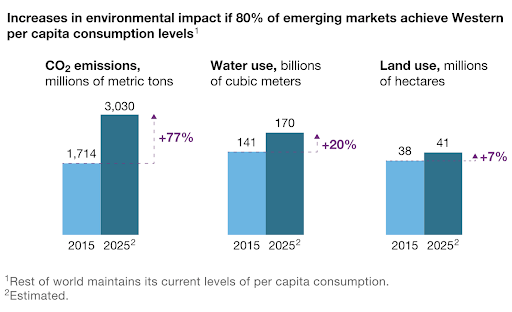The Fast Fashion Trade-off

For the past decade, many of our recreational decisions and desires have been influenced by social media. Whether it's choosing to go on certain holiday destinations, restaurants, or choosing what outfits to wear and picking what’s trending. While it may be a good source to pick up trends from, social media, arguably, not only pressurises people to constantly update their wardrobes, but also sets forth the idea of shopping from sources that are not necessarily sustainable. Rather, it tends to focus more on fast moving apparels that are refreshed and updated in as little as a week’s time – commonly termed as “fast fashion”.
Just like most of us do, I spend a lot of time aimlessly scrolling through Instagram. And the more I do, the more I wonder - are people really so unaware of the consequences of fast fashion, or are they just being ignorant and deliberately choosing to look the other way? Broadly put, these consequences can be divided into two major categories: human rights issues and environmental impact. While the former includes exploitation of labour in poor countries and violation of their right to access to basic workplace security and compensations, the latter comprises issues such as global carbon emissions and the impact on the ever worsening climate crisis.
I'll start with a question - have you ever wondered where your £5 crop top came from and why it cost so little money? It might be super affordable, but has it occurred to you that maybe someone else across the globe is paying the price for it? Working extra hours, very little wage compensation, unhealthy environments in the industries, child labour – few of the many ways workers are being exploited to make those £5 crop tops.
On 24 April 2013, in one of the deadliest industrial disasters in world history, the Rana Plaza building in Dhaka, Bangladesh collapsed. The collapse of this building, which housed multiple garment factories (including Walmart, Primark and Mango), took the lives of at least 1,132 people and injured over 2,500. And at what cost? Given the poor labour policies in place in Bangladesh at the time, the families of the deceased received little to no compensation despite losing their only breadwinner in the family, pushing them further into dire poverty.
Almost all of us have that one outfit we pull out of our closets on days we don’t feel like putting too much effort into what we’re wearing, labeling it something like “basic, but chic”, and often posting a selfie on our Instagram stories. But have you ever thought about how that outfit that seems effortless to you has actually taken so much from our environment in its manufacturing process, and will continue to do so until it arrives at its end of use. To be precise, it took roughly 2,700 litres of water to make that one cotton t-shirt (which is enough water for one person to drink for about 2.5 years). Furthermore, making and washing one pair of jeans emits the same levels of CO2 as you driving about 69 miles in your car. Did this shock you as much as it did me?!
According to the World Economic Forum, the fashion industry is responsible for 10% of all greenhouse gas (GHG) emissions – this roughly accounts for more than that of all international flights and shipping COMBINED. Even whilst you’re reading this blog, one garbage truck full of textiles is being incinerated or sent to landfills somewhere in the world, every second. To add to that, even luxury brands, which are often such a status symbol in today’s day and age, are creating so much harm to the environment. Did you know that all the merchandise they are unable to sell, they choose to incinerate, as opposed to offering a discount for these products, because the latter will supposedly hurt their “image”? A few examples of these are high street brands such as Burberry, Gucci, Michael Kors, Victoria’s Secret, among many others.
To put things into perspective, this graph shows the harm we are causing, and will continue to cause, to the environment through fashion:

However, I also want to highlight that the narrative around fashion seems to be changing. It is no more about filling your closets with as many clothes, shoes and accessories as possible. Attitudes seem to be shifting towards a more conscious approach to fashion – one that chooses longevity over trends. People are now being more conscious of where they buy from, and charity shops are becoming popular – I personally love it, there’s gold in those little stores!
One very good example for a change in narrative is the brand Patagonia. I am sure many of you have heard of it, but there are many reasons why it is so popular – popularity that differentiates it from other big fashion houses such as Zara, H&M, and the likes. Along with being a B Corp, they follow five waste combating principles: Reduce, Reuse, Repair, Recycle and Reimagine. To elaborate, they not only use recycled materials in producing all their gear, but also offer a lifetime repair guarantee to customers in order to encourage them to buy less and extend the life of their garments.
Now, I’m not here to call anyone out on their shopping choices. I’m not here to tell you to suddenly stop buying expensive things. All I’m saying is – as a first next step, perhaps let’s all start by not throwing away clothes after we’ve worn them once or twice. That’s an easy start, right? Follow this by washing smart, i.e. use eco-detergent and air dry as much as possible. This can be accompanied by upcycling, repairing and sharing clothes with people you’re comfortable with. This will allow each item to be used until its end life.
There are also lots of gaps in the current policy landscape around incentivising more responsible production of the aforementioned products. In order to move away from the current industry rates (which misses the 1.5°C pathway by 50%), it not only requires governments, fashion houses, and consumers to work together to promote more sustainable production and consumption. Changing the trajectory of fashion also calls for mass collaboration across the entire value chain: starting from the utilisation of raw materials to the way we dispose, reuse and recycle garments. Collective action is the only way that can deliver the Paris Agreement.
Fashion is a choice we make every day, and how we make that choice defines everything. We make the choice between either buying five dresses for £80 and only wearing them a few times, or buying one dress for the same £80, wearing and styling it in multiple ways, and making it last. I often find myself in situations where I feel the need to buy new clothes, but for a while now, I have chosen to start with buying less, if nothing else. Hereon, I hope to make more conscious fashion choices and aim to seek transparency from brands I engage with.
As changemakers in the impact space, I invite you to do the same. The climate landscape is shifting drastically, and to be able to even remotely contain this, we need to act now. I leave you with this documentary that, hopefully, will change your perception of fast fashion, if this blog hasn’t managed to do so – The True Cost.
Image from Unsplash
